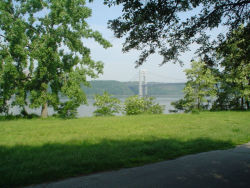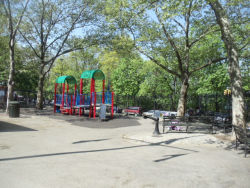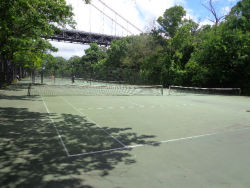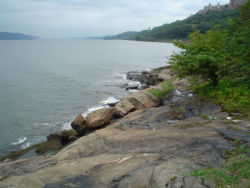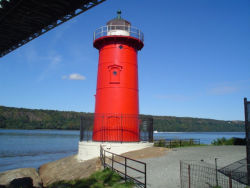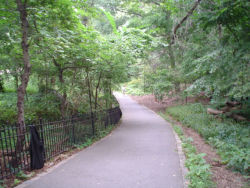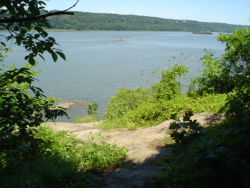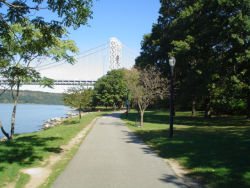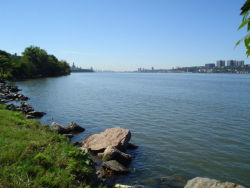Fort Washington Park
Fort Washington Park
What was here before?
Prior to European settlement, the Lenape plied the turbulent waters of the North (Hudson) River shallows, and this promontory was a rural green bluff facing the rugged cliffs of New Jersey’s
Palisades.
During the American Revolutionary War, the area became a strategic military site. On June 20, 1776, Pennsylvania battalions under General George Washington’s command constructed a five‑bastion earthen fort atop Manhattan’s highest hill (now near Fort Washington Avenue and West 183rd Street). On November 16, 1776, British and Hessian forces captured Fort Washington taking over 4,000 prisoners. The British occupied New York City until the war ended in 1783. Between 1779 and 1780, German general Baron von Knyphausen led the garrison, and the fort was briefly renamed Fort Knyphausen. After the war, the fort disappeared, the area developed into Washington Heights, and its former footprint is now marked by granite outlines in Bennett Park.
Just west of the park lies Jeffrey’s Hook, a small point of land along the Hudson River near the base of the George Washington Bridge. The origin of its name is unclear, but it’s believed to refer to a local fisherman or landowner named Jeffrey (or Geoffrey) from the colonial era. The word “hook” comes from the Dutch hoek, meaning “point” or “corner,” reflecting the site’s geography.
In the 19th and early 20th centuries, Jeffrey’s Hook became important for shipping and river navigation. The iconic landmark is the Little Red Lighthouse, officially named Jeffrey’s Hook Lighthouse. Originally built in 1880 at Sandy Hook, New Jersey, the 40-foot cast-iron beacon was relocated to Jeffrey’s Hook in 1921 to guide ships through the narrow and hazardous waters between Manhattan and New Jersey. The lighthouse became nationally beloved through the 1942 children’s book, The Little Red Lighthouse and the Great Gray Bridge, by Hildegarde Swift and Lynd Ward. Though decommissioned in 1948 due to the George Washington Bridge’s powerful lights, the lighthouse was saved from demolition in 1951. That year, ownership was transferred to the City of New York. Now a historic landmark, the lighthouse was added to the National Register of Historic Places in 1979 and fully restored in 2002.
How did this site become a park?
The Laws of 1894 mapped this park, which now stretches from West 155th Street to Dyckman Street and from Riverside Drive to the Hudson River, as parkland and named it Fort Washington Park. The City of New York officially acquired most of the property in five separate parcels between 1896 and 1927, all through condemnation. Parks was granted jurisdiction at the time of those acquisitions, but some additional parkland was added from the Port of New York Authority (1939), the Board of Estimate (1966), and the Department of Real Property (1989).
Inspiration Point Shelter, on Henry Hudson Parkway at West 190th Street, opened in 1925 as a resting place for pedestrians and leisure drivers. Designed by architect Gustave Steinacher in 1924, the neoclassical sitting area opened a year later and quickly became a favorite of Hudson River tourists. In 1927, the Board of Estimate allowed Parks to relinquish control of a parcel of land at West 179th Street for the Port of New York Authority’s construction of the George Washington Bridge. When completed in 1931, it was the longest suspension bridge in the world.
The West 181st Street Beautification Project and the New York Restoration Project help Parks ensure that Fort Washington Park can provide diverse opportunities for rest and recreation. Park amenities include baseball fields, basketball courts, tennis courts, and a playground for active recreation and benches and sitting areas for those who simply want to take in the views. Each September, the Little Red Lighthouse Festival brings hundreds of lovers of children’s literature and nautical history to Fort Washington Park and its most famous landmark, in the shadow of the “Great Gray Bridge.”
Check out your park's Vital Signs
Clean & Safe
Green & Resilient
Empowered & Engaged Users
Share your feedback or learn more about how this park is part of a
Vital Park System

